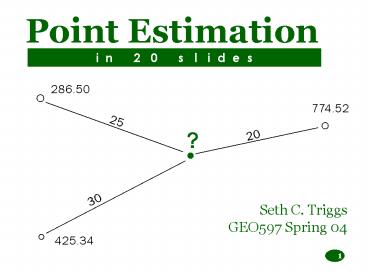Point Estimation - PowerPoint PPT Presentation
1 / 20
Title: Point Estimation
1
Point Estimation
i n 2 0 s l i d e s
286.50
774.52
25
?
20
30
Seth C. Triggs GEO597 Spring 04
425.34
2
What is point estimation?
- Point estimation is an estimation of a value
based on the distance from the unknown. This is
in a sense an application of Toblers First Law
of Geography - Close things are more related than far things!
3
Polygon usage
- Many triangulation methods involve polygons.
4
After figure 11.1
To create polygons of influence, draw
perpendicular bisectors! (also see figure 10.2 in
text)
EXAMPLE
5
Look at these sharp differences between the
polygons of influence! (after Figure 11.2)
6
Triangulation
- Politicians do it - many of us do it - it
involves making a plane through three samples
around the point of interest. - This plane is a triangle and its slope represents
the gradient between points. - Equations
(11.2)
ax1 by1 c z1 ax2 by2 c z2 ax3 by3
c z3
(11.1)
z ax by c
7
(11.4)
(11.5)
(11.3)
Triangulation estimator v -11.25x 41.614y -
4421.159
63a 140b c 696 64a 129b c 227 71a
140b c 606
When solving, a -11.250, b 41.614, c
-4421.159
(65E, 137N) 548.7
Think of this like the slope of a mountain the
highest point is 696, then 606, then 227. You
could even map it and put contour lines on.
(after Figure 11.3)
8
Delaunay Triangulation
- This requires polygons of influence
- Three polygons must share a vertex.
(after figure 11.4)
9
Weighted Linear Combination
- Another type of triangulation estimate that
produces a similar result. - This one uses a single equation instead of three
in regular triangulation.
(After Fig. 11.5)
J
(11.6)
AOIJ
AOJK
O
AOJK vI AOIK vJ AOIJ vK AIJK
vO
AOIK
K
I
10
Local Sample Mean
- By taking a local sample mean, we can get a
quick and dirty method for estimation.
11
Inverse Distance Methods
- For each sample, the weight is inversely
proportional to its distance from the point of
interest. - Thus, as distance decreases, weight increases.
(11.8)
n i1
1 di
vi
v
n i1
1 di
12
ID SAMP X Y V Dist 1/di (1/di)/(
1/di) 1 225 61 139 477 4.5 0.2222 0.2088 2 437 63
140 696 3.6 0.2778 0.2610 3 367 64 129 227 8.1 0.1
235 0.1160 4 52 68 128 646 9.5 0.1053 0.0989 5 259
71 140 606 6.7 0.1493 0.1402 6 436 73 141 791 8.9
0.1124 0.1056 7 366 75 128 783 13.5 0.0741 0.0696
1/di 1.0644
Mean is 603.7
After Table 11.2
13
Search Neighborhoods
- Sometimes we need to specify how far away we want
to look to find a neighbor. - You wouldnt want to hunt 500 miles for the
nearest neighbor, because that could be expensive
in terms of time.
14
Estimation Criteria
- These criteria differ by the distribution of your
data. Youll get different results by changing p,
the exponent.
(11.9)
1
n i1
vi
p i
d
v1
1
n i1
p i
d
15
For univariate estimate distributions
- You can compare the mean and standard deviation
between the estimated and true values!
n
Mean Absolute Error (11.11)
1 n
r
i 1
MSE variance bias2
Mean Squared Error (11.12)
n
1 n
r2
i1
16
For univariate error distributions
- Youll want to have a small variance in
residuals, not a small bias. - There is a true value v and an estimated value v.
- Thus, the error is v - v r. Its also called a
residual.
Based on figure 11.9
Less variance with bias
Large variance without bias
f
17
For bivariate estimated and true values
- If you plot your true versus predicted values,
you can also get an indication of how well the
model holds. - The best values form a line of 45 degrees from
the origin.
18
Some case studies
- Smoothing - sometimes estimated values have a
smaller variance than sample values because
estimations use weighted linear averages of
several samples. - Figure 11.13 gives an indication of the
performance of the different estimation methods.
Table 11.16 gives statistics. - It appears that polygonal performs better.
(See figure 11.13)
19
Additionally
- We can look at how clustering affects samples and
the estimates. - Triangulation seems better because of its low
standard deviation. - Largest errors can be minimized by inverse
distance weighing. See tables 11.7 and 11.8.
20
The End!
- An excellent antidote to PowerPoint poisoning is
black coffee. Get it at your favorite coffee shop
or convenience store.

